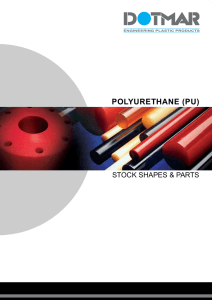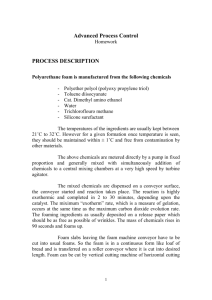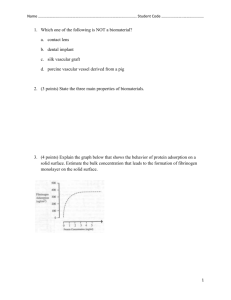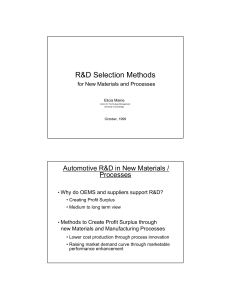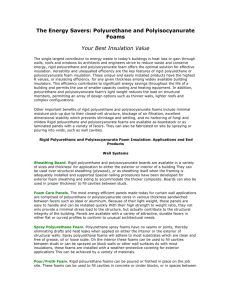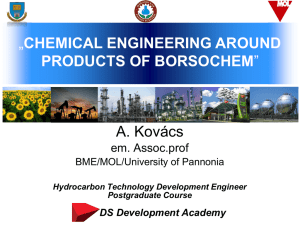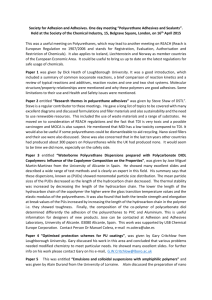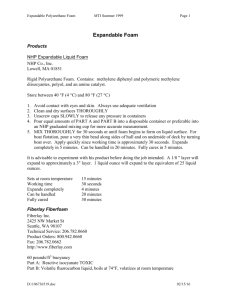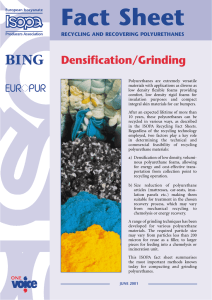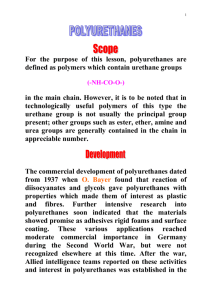Polyurethane - University of Nebraska Omaha
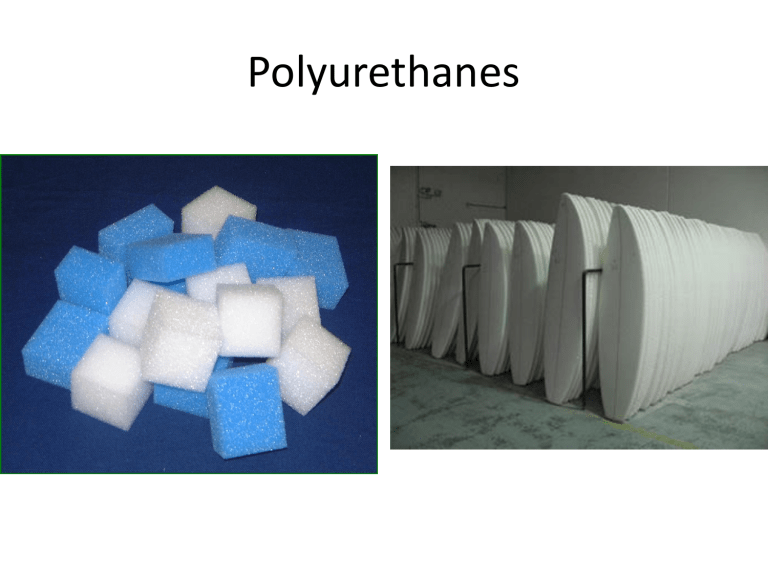
Polyurethanes
History of Polyurethanes:
Polyurethane Chemists
• Dr. Otto Von Bayer
(1937)
– IG Farben Industries
• Rigid and flexible foams
• TDI and polyols
– Attempts to reduce natural rubber use
History of Polyurethanes:
Polyurethane Chemists
• Adolf Wurtz (1848)
• Karl-Heinz Hentschel (1884)
– Phosgenation of amines
Isocyanate Monomer Synthesis
• Dr. Otto Bayer (1937)
– First diisocyante synthesis
• Toluene Diisocyanate Synthesis (TDI)
– Reaction creates 80/20 mixture of 2,4-TDI and 2,6-TDI
Isocyanate Monomer Synthesis
• Diphenylmethane Diisocyanate (MDI) Synthesis
– Attempt to find less toxic monomer for PU reactions
– MDI chemistry is more complex
• Allows for more specific applications
Imperial Chemical Industries
• ICI and WWII applications of isocyanates
– Barrage balloons
• Used MDI as cross-linking agent
– Resistant to hydrogen
– Applications also included rigid foams in planes
• War applications soon faded
• Isocyanates and water
• Carbon dioxide is side product
• Initially a defect it was turned into an application as foam
• ICI takes notes from Bayer AG
– Designs a machine outside of the Germans patented machine
Imperial Chemical Industries
• Toxicity of TDI (1950s)
– Led to design of MDI/polyester systems
• Portable refrigerators, domestic chambers of ships, chemical plan insulation
• Further improvements with CFC’s
– CFC blowing agents created superior insulating foams
• Thin walled refrigerators create interest rigid PU foams around the world
Polyurethanes
• Polyurethanes are much more than just foam
• PU’s can be
– Elastomers
– Paints
– Adhesives
– Fibers
• Spandex
Breakdown of the PU Industry
Figure from Essentials
Chemical Industry on
University of York website
Economics
• The PU industry was estimated to produce
13.65 million tons of plastic in 2010 and is expected to grow to 17.95 million tons by
2016
• The PU industry is expected to grow from $33 billion in 2010 to $55.5 billion in 2016
• North America, Asia-Pacific, and Europe account for 95% of the PU market
Numbers found from source 6
Polyurethane Structure
Carbamate bonds created by isocyanates reacting with hydroxy groups of a polyol
Polyurethane Reactions
• Tertiary amines catalyze the reactions
• Isocyanate groups react with polyols
Polyurethane Monomers
• Polyurethanes consist of different block co-polymers
• MDI- 4 4'-diphenylmethane diisocyanate
• TDI- Toluene-2,4-diisocyanate
Polyurethane Monomers
Polyols- hydroxy terminated polyether, polyester, polyolefins, and glycols
Polyurethane:
Block Copolymers
• Soft block/hard block microphases
-Poly(1,4-butylene adipate) is part of the soft block microphase
-Soft blocks have 600-3000 MW and T g below room temperature
-The soft block cross-link interaction with the hard block gives rise to the rubbery nature of these elastomers
-The hard block consists of TDI or MDI
-Higher density of phenyl rings and urethane links cause hardness
Figures from source 7
Soft/Hard Block H-Bonding
Interactions
Importance of Polyol choice
Figures from source 7
Polyurethane Reactions
• Multiple types of reactions make up different end products of polyurethanes
• Polyurea reactions are important for spandex production
Which sometimes can be a bad thing!
• Someone needs to introduce this guy to pants and suspenders!
• Suspenders are made of polyesters
– Dr. Tisko should tell this guy how awesome suspenders are
Bibliography
1.
http://www.pslc.ws/macrog/urethane.htm
2.
http://www.8linx.com/cnc/polyurethane_foam.htm
3.
http://www.essentialchemicalindustry.org/polymers/polyurethane.html
4.
http://sunilbhangale.tripod.com/pu.html
5.
http://www.poliuretanos.com.br/Ingles/Chapter1/132comercial.htm
6.
http://www.plastemart.com/Plastic-Technical-
Article.asp?LiteratureID=1674&Paper=global-polyurethane-market-PU-foamsthermoplastic-elastomers
7. J.M. Buist. Developments In Polyurethane-1; Applied Science Publishers LTD, UK,
1978.

